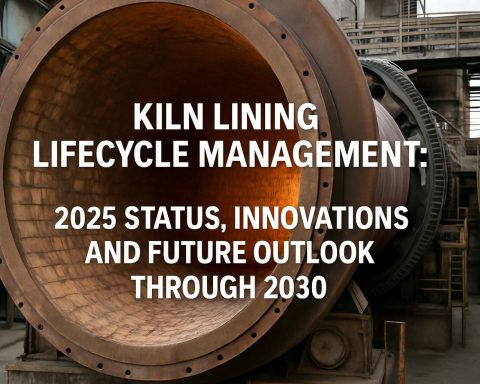Table of Contents
- Executive Summary: Key Trends and Market Drivers in Lignin Upcycling Nanomaterials
- Lignin Nanomaterials Explained: Properties, Types, and Unique Advantages
- 2025 Market Forecast: Growth Projections and Revenue Estimates
- Cutting-Edge Upcycling Technologies: Processes, Efficiency, and Scalability
- Major Industry Players and Strategic Partnerships
- Application Hotspots: Packaging, Bioplastics, Energy, and Beyond
- Emerging Startups and Innovations to Watch
- Supply Chain, Raw Material Sourcing, and Sustainability Impact
- Regulatory Environment and Industry Standards (e.g., pulpandpaper.org, forestproducts.org)
- Future Outlook: Opportunities, Challenges, and Disruptive Trends to 2029
- Sources & References
https://youtube.com/watch?v=S68W0640rfM
Executive Summary: Key Trends and Market Drivers in Lignin Upcycling Nanomaterials
Lignin upcycling nanomaterials are emerging as a pivotal segment in the sustainable materials landscape, with 2025 marking an inflection point for both technological advancement and early-stage commercialization. Key drivers fueling this momentum include increasing regulatory pressure for carbon footprint reduction, the proliferation of bio-based product mandates, and escalating demand from sectors such as packaging, automotive, and construction for renewable nanomaterials with advanced performance characteristics.
In 2025, the market is witnessing accelerated efforts to transition lignin—a byproduct of the pulp and paper industry as well as biorefineries—into high-value nanomaterials such as lignin nanoparticles (LNPs) and lignin-based nanocomposites. These materials offer superior UV resistance, mechanical strength, and antioxidant properties, making them attractive for integration into bioplastics, coatings, and adhesives. Industrial players are increasingly focused on scalable extraction and modification techniques, with both enzymatic and solvent-based processes being optimized for higher purity and yield.
Companies such as Stora Enso and UPM-Kymmene Corporation are leading the charge in lignin valorization, investing in pilot-scale facilities and forging partnerships for downstream applications. Stora Enso’s Sunila Mill in Finland continues to serve as a benchmark, producing industrial lignin for advanced materials, with the company increasingly exploring nanolignin for functional additives and composites. Similarly, UPM-Kymmene Corporation is advancing its Biofore strategy by integrating lignin nanomaterials into novel green chemistry applications.
Innovation is also being propelled by collaborations between industrial and research actors, with organizations such as Fraunhofer-Gesellschaft supporting the development of lignin-derived carbon nanomaterials for next-generation batteries and supercapacitors. These developments are complemented by advancing pilot projects targeting bio-based foams and resins for automotive interiors and building insulation.
Looking ahead, the next few years will likely see lignin upcycling nanomaterials transition from pilot to early commercial scale, driven by cost-down efforts, regulatory incentives, and continued end-user adoption in Europe, North America, and parts of Asia. The focus will be on optimizing supply chains, improving material performance consistency, and integrating lignin nanomaterials into established circular economy platforms. As more manufacturers look to decarbonize their portfolios and reduce reliance on fossil-based raw materials, lignin upcycling nanomaterials are set to become a cornerstone of sustainable advanced material strategies globally.
Lignin Nanomaterials Explained: Properties, Types, and Unique Advantages
Lignin upcycling nanomaterials are emerging as a transformative class of bio-based nanomaterials, leveraging the abundant and underutilized lignin component of lignocellulosic biomass. In 2025, these materials are gaining increased attention due to their unique physicochemical properties, sustainability credentials, and potential for integration into a broad range of industrial applications. Lignin, the second most abundant biopolymer on earth, has traditionally been treated as a low-value byproduct in the pulp and paper industry. The upcycling of lignin into nanoscale materials not only adds significant value but also aligns with circular economy principles and carbon-neutral manufacturing goals.
Lignin nanomaterials are typically categorized into lignin nanoparticles (LNPs), lignin nanofibers, and hybrid lignin-based nanocomposites. LNPs, roughly 50-200 nm in diameter, exhibit high surface area, tunable surface chemistry, and inherent antioxidant and UV-absorbing properties. These features make them excellent candidates for advanced functional materials in packaging, coatings, pharmaceuticals, and agriculture. Lignin nanofibers, produced via electrospinning or mechanical processes, combine high tensile strength with biodegradability, offering new solutions for sustainable textiles and filtration systems.
A defining advantage of lignin nanomaterials is their intrinsic multifunctionality. Lignin’s aromatic structure imparts superior radical scavenging capacity, natural antimicrobial activity, and UV protection, properties that are increasingly desirable in eco-friendly product formulations. Additionally, lignin’s compatibility with other biopolymers, such as cellulose and starch, enables the fabrication of high-performance, fully bio-based composites. Companies like Stora Enso and Domtar have signaled growing interest in valorizing lignin streams for nanomaterial production, with pilot-scale facilities and partnerships focused on the development of lignin-based dispersions and powders for specialty markets.
Recent advances in controlled self-assembly, green chemistry synthesis, and scalable fractionation are accelerating the commercial viability of lignin nanomaterials. Research and demonstration projects, especially in Northern Europe and North America, are targeting applications where biodegradability, renewability, and reduced carbon footprint are critical selling points. Organizations such as Innventia are collaborating with industry to tailor lignin nanomaterial properties for specific end uses, including barrier-enhanced packaging and bioactive films.
Looking ahead, the next several years are expected to see rapid expansion in lignin upcycling nanomaterials, driven by legislative pressures for sustainable materials, advances in process engineering, and growing market demand for circular bio-based alternatives. As scalable extraction and processing technologies mature, lignin nanomaterials are poised to become a cornerstone of the emerging bioeconomy.
2025 Market Forecast: Growth Projections and Revenue Estimates
The market for lignin upcycling nanomaterials is poised for notable expansion in 2025, driven by advances in green chemistry, increased demand for sustainable materials, and growing industrial interest in lignin valorization. Lignin, an abundant biopolymer derived from biomass, is increasingly being transformed into high-value nanomaterials for applications in composites, coatings, energy storage, and biomedicine. Leading industry participants and research-active corporations are scaling up production and commercialization, signaling a shift from pilot-scale demonstrations to early market entry.
Within 2025, the global market size for lignin-derived nanomaterials is anticipated to reach a valuation in the high double-digit millions (USD), with a compound annual growth rate (CAGR) estimated in the range of 20–25% through the next several years. This growth trajectory is underpinned by the ongoing efforts of companies such as Stora Enso and UPM, both of which have invested in lignin extraction and upcycling technologies, incorporating lignin-based nanoparticles into specialty chemicals, adhesives, and advanced materials.
In 2025, demand is set to intensify particularly from the automotive, packaging, and electronics sectors, where lignin nanomaterials offer lightweighting, barrier, and functional properties. For instance, Stora Enso has demonstrated the use of lignin nanoparticles for advanced carbon materials and as sustainable alternatives in battery technologies. Similarly, UPM is developing lignin-based nanomaterials for high-performance biocomposites, targeting both European and Asian markets.
Another key driver is the alignment of lignin upcycling with corporate and governmental sustainability targets. Organizations such as Novozymes are collaborating with lignin stakeholders to integrate enzymatic processes for nanomaterial production, while the European Union continues to fund demonstration projects to accelerate scale-up and industrial adoption. The transition from lab-scale synthesis to commercial output is expected to lower manufacturing costs and enhance competitiveness with petroleum-based nanomaterials.
Looking forward, the outlook for 2025 and the following years is characterized by robust investment in process optimization, partnerships between pulp and paper giants, chemical manufacturers, and startups focused on nanocellulosic and lignin-based materials. As end-user industries amplify their sustainability requirements, lignin upcycling nanomaterials are positioned to capture a growing share of the advanced materials market, with revenue estimates rising sharply as new applications and regulatory incentives come online.
Cutting-Edge Upcycling Technologies: Processes, Efficiency, and Scalability
Lignin upcycling into nanomaterials is rapidly evolving as a transformative approach in the valorization of lignocellulosic biomass. In 2025, the focus intensifies on scalable processes that convert lignin—a complex aromatic polymer and a byproduct of pulp, paper, and bioethanol industries—into high-value nanomaterials. These nanomaterials, including lignin nanoparticles (LNPs) and nanostructured films, offer unique physicochemical properties, making them attractive for applications in packaging, coatings, energy storage, and biomedical fields.
Key industry players are advancing methods that address the heterogeneity and recalcitrance of technical lignins. Recent developments emphasize green and solvent-free techniques, such as anti-solvent precipitation, ultrasonication, and self-assembly under mild conditions. For instance, companies like Stora Enso and UPM are scaling up processes for producing functional lignin nano- and microparticles. Stora Enso’s Lignode® product line is an example, targeting sustainable battery anodes using lignin-derived nanomaterials, with pilot-scale facilities operational and further capacity expansion planned into 2025.
Efficiency gains are being realized by optimizing lignin purification, fractionation, and dispersion. This reduces polydispersity and tailors surface chemistry, enhancing compatibility with diverse polymer matrices. In 2025, industrial-scale reactors with improved process controls facilitate the continuous production of uniform LNPs, addressing a key hurdle for commercial adoption. Additionally, new functionalization techniques—such as grafting with hydrophilic or hydrophobic moieties—are unlocking tunable properties for end-use applications, as demonstrated by R&D initiatives at Borregaard, a leading biorefinery operator.
Scalability remains a central challenge. The transition from laboratory to pilot- and commercial-scale production involves engineering reactors capable of handling metric-ton lignin inputs while ensuring product consistency. Collaborative efforts between technology providers and end-users are fostering the development of robust supply chains. For example, Stora Enso and UPM are engaging with packaging and electronics manufacturers to validate the performance of lignin nanomaterials in real-world applications.
Looking ahead, the outlook for lignin upcycling nanomaterials in 2025 and beyond is promising. Regulatory support for sustainable materials, together with demonstrated lifecycle benefits, is accelerating market entry. Ongoing investments in process intensification, automation, and standardization are expected to further bridge the gap between innovation and commercialization. As a result, lignin nanomaterials are positioned to play a pivotal role in the transition towards bio-based and circular material economies.
Major Industry Players and Strategic Partnerships
The landscape of lignin upcycling nanomaterials is evolving rapidly as the bioeconomy seeks sustainable, high-performance alternatives to fossil-derived materials. In 2025, several major industry players are leading the development and commercialization of lignin-based nanomaterials, leveraging strategic partnerships to accelerate innovation and market entry.
A prominent player is Stora Enso, one of the world’s largest pulp and paper producers, which has invested in commercial-scale production of lignin and its downstream applications. Stora Enso’s “Lineo” product line converts kraft lignin into functional materials for adhesives, batteries, and nanocomposites. Strategic alliances with battery manufacturers in Europe are underway, aiming to replace fossil-based carbon in energy storage devices with lignin-derived alternatives. The company is also collaborating with research institutes to optimize lignin nanoparticles for advanced material functionality.
Another key actor is UPM, which has positioned itself as a frontrunner in lignin valorization. UPM’s biorefinery operations focus on integrating lignin nanomaterials into resins, coatings, and plastics, targeting sectors such as automotive and construction. In 2025, UPM continues to expand its partnership network within the European Union, joining forces with manufacturers and startups to scale lignin nanoparticle production and application development.
North American players are also making significant strides. Domtar has established collaborations with specialty chemical companies and universities to refine lignin upcycling processes and develop nanostructured lignin for polymer composites and functional coatings. Their focus includes the upscaling of pilot plants and integration into existing pulp mills, aiming for market-ready solutions in the next few years.
In the Asia-Pacific region, Nippon Paper Industries is advancing lignin nanomaterial research, with a focus on functional additives for packaging and electronics. The company is leveraging domestic partnerships to accelerate product development and commercialization, emphasizing the circular economy and carbon footprint reduction.
Strategic partnerships between industrial producers, research institutions, and end-users are key drivers in this sector. The formation of consortia, such as those facilitated by Celignis and pan-European bioeconomy alliances, is expected to foster standardization, regulatory alignment, and shared technology platforms. Looking ahead, the next few years are poised to see increased cross-sector collaborations, pilot-to-commercial scale transitions, and the integration of lignin nanomaterials into mainstream products, signaling robust market growth and technological maturation.
Application Hotspots: Packaging, Bioplastics, Energy, and Beyond
Lignin upcycling nanomaterials are rapidly emerging as a transformative solution across multiple industries, driven by the global push for sustainable alternatives to fossil-based materials. In 2025 and the coming years, the application hotspots for these nanomaterials will be most prominent in packaging, bioplastics, energy storage, and advanced composites, with significant momentum generated by industrial collaborations and pilot-scale process implementations.
In packaging, the surge in demand for eco-friendly materials is fostering the integration of lignin-derived nanomaterials into films, coatings, and containers. Several manufacturers have demonstrated that lignin nanoparticles can enhance barrier properties, improve UV resistance, and provide antioxidant functionalities in packaging films, making them an attractive replacement for petroleum-based additives. The sector is witnessing partnerships between pulp and paper producers and packaging innovators to scale up these lignin nanomaterial solutions, reflecting a clear commercial pathway as regulatory pressures intensify on single-use plastics.
Bioplastics represent another high-impact application. Lignin nanomaterials are being incorporated as bio-based fillers or blending agents to reinforce biopolymer matrices, such as polylactic acid (PLA) and polyhydroxyalkanoates (PHAs). The addition of lignin nanoparticles markedly improves mechanical strength and thermal stability, while also imparting antimicrobial properties. Leading bioplastics manufacturers are actively exploring such solutions for consumer goods, food packaging, and agricultural films, aiming to achieve both performance gains and sustainability credentials. This trend is set to accelerate as industrial players seek to differentiate their products in a crowded marketplace.
In the energy sector, lignin upcycling nanomaterials are gaining traction in the development of advanced electrodes for batteries and supercapacitors. Lignin’s intrinsic aromatic structure provides a renewable carbon source for fabricating nanostructured carbon materials, which can be used in lithium-ion battery anodes and electrochemical capacitors. Organizations with deep roots in pulp and paper production, such as Stora Enso and UPM-Kymmene Corporation, have publicly highlighted lignin’s potential in energy storage applications, with several ongoing demonstration projects and early-stage commercial deployments anticipated through 2025 and beyond.
Beyond these core sectors, lignin upcycling nanomaterials are also being trialed in specialty coatings, adhesives, and biomedical carriers. Their unique combination of biodegradability, tunable surface chemistry, and antioxidant activity is attracting attention for functional coatings and drug delivery systems. As manufacturing scale increases and processing costs decrease, the coming years will likely see lignin nanomaterials become a mainstream ingredient in a diverse set of advanced material solutions, underpinning the circular bioeconomy vision shared by leading industry stakeholders.
Emerging Startups and Innovations to Watch
The field of lignin upcycling nanomaterials is rapidly evolving, with several startups and innovators positioning themselves to transform lignin—a complex, aromatic polymer often considered a waste product of the pulp and paper industry—into high-value nanomaterials for a range of applications. As of 2025, the momentum is driven by both technological breakthroughs and increased industrial demand for sustainable, bio-based alternatives in sectors like packaging, energy storage, coatings, and bioplastics.
Among the most notable innovators is Stora Enso, a global leader in renewable materials, which is advancing its Lignode® technology for bio-based carbon materials. Lignode® utilizes lignin sourced from Nordic softwood, upcycled into hard carbon for use in sustainable battery anodes. This innovation is being scaled up, with pilot production lines operational and further industrial-scale expansion anticipated over the next few years.
Another key player is Neste, which has announced investments and collaborations aimed at converting lignin and other side streams into advanced biomaterials, including nanostructured additives for plastics and composites. Neste’s focus is on integrating lignin-derived nanomaterials into existing industrial value chains, targeting both performance and environmental benefits.
Startups are also making significant strides. RenCom, a Swedish company, specializes in upcycling lignin into renewable carbon nanomaterials, such as REPLACE™, a lignin-based additive designed to enhance the mechanical and barrier properties of bioplastics. RenCom’s pilot plant, commissioned in 2023, is scaling up in 2025 to meet growing customer demand in the packaging and construction industries.
In North America, Domtar is supporting the commercialization of lignin nanomaterials through partnerships and technology licensing. Their focus includes lignin nanoparticles for advanced adhesives and coatings, with pilot trials underway in 2025 and plans for expanded manufacturing capacity if market validation continues positively.
Looking forward, the next few years are expected to see increased investment in lignin upcycling startups, driven by regulatory pressures on plastics and carbon-intensive materials, as well as corporate sustainability commitments. Advances in process intensification, especially in fractionation and functionalization of lignin at the nanoscale, will likely yield new classes of nanomaterials with tailored properties for specific end uses. The sector is set to benefit from collaborative initiatives between large industrials and agile startups, accelerating the path from laboratory innovation to commercial deployment.
Supply Chain, Raw Material Sourcing, and Sustainability Impact
The supply chain for lignin upcycling nanomaterials is undergoing notable transformation as global industries increase their emphasis on circular bioeconomy and sustainable sourcing in 2025. Lignin, a major byproduct of the pulp and paper industry, is currently produced in excess of 70 million tons annually worldwide, with only a small fraction being valorized into high-value products. The majority is combusted for energy recovery, but advancements in upcycling technologies are enabling higher-value applications, especially in nanomaterials for composites, coatings, and energy storage.
Raw lignin is primarily sourced from large-scale pulp and paper producers, with regions such as North America, Scandinavia, and parts of Asia acting as major suppliers. Companies like Stora Enso and UPM-Kymmene Corporation have increased investments in fractionation and purification processes to deliver consistent lignin feedstock suitable for nanomaterial upcycling. In 2025, these companies continue to scale up their biorefinery operations, focusing on the extraction of high-purity kraft and organosolv lignins tailored for downstream nanotechnology applications.
The sustainability impact of lignin upcycling into nanomaterials is substantial. By diverting lignin from low-value uses such as combustion, industries are able to reduce greenhouse gas emissions and fossil resource dependence. Life cycle assessments performed by stakeholders, including Stora Enso, indicate that lignin-derived nanomaterials can offer up to 50% lower CO2 footprint compared to petroleum-based nanomaterials in certain applications. Moreover, these nanomaterials are increasingly finding use in biodegradable and recyclable products, aligning with global regulatory trends for green materials.
Supply chain traceability and raw material certification are also advancing, with organizations such as the Programme for the Endorsement of Forest Certification (PEFC) promoting sustainable forest management as a prerequisite for lignin sourcing. In addition, collaborations between technology developers and pulp producers are streamlining logistics and reducing transportation emissions by integrating lignin processing at the source.
Looking ahead, the supply chain for lignin upcycling nanomaterials is expected to mature rapidly within the next few years. With ongoing investments from manufacturers and growing demand for sustainable nanocomposites, the sector is poised to move beyond pilot scale into industrial-scale production by 2027. This trajectory is supported by increasing partnerships between biorefinery operators and end-use industries in automotive, packaging, and electronics, further bolstering the sustainability credentials of lignin-based nanomaterials.
Regulatory Environment and Industry Standards (e.g., pulpandpaper.org, forestproducts.org)
The regulatory environment for lignin upcycling nanomaterials is rapidly evolving as industry adoption accelerates in 2025. Key drivers include the circular bioeconomy push in Europe, North America, and Asia-Pacific, alongside tightening requirements for sustainable materials and nanotechnology safety. Lignin, a byproduct of the pulp and paper industry, is increasingly valorized into high-value nanomaterials for applications such as composites, coatings, packaging, and energy storage.
Historically, lignin was viewed as waste or burned for energy. However, with the rise of advanced nanomaterial processing, regulatory agencies are issuing new guidelines to ensure safe handling, environmental compatibility, and transparent lifecycle assessments. The Pulp and Paper Technical Association and Forest Products Society have both begun convening working groups in 2024–2025 to establish best practices for the characterization, application, and disposal of lignin-based nanomaterials. These efforts are intended to harmonize standards with existing frameworks for nanomaterials, such as those provided by the International Organization for Standardization (ISO) and the Organisation for Economic Co-operation and Development (OECD).
In the European Union, the REACH Regulation continues to require comprehensive registration and risk assessment for new nanomaterials, including lignin-derived nanoparticles. Industry stakeholders have been collaborating with regulatory bodies to clarify data requirements specific to biogenic nanomaterials. Major lignin upcycling players are participating in these dialogues to streamline approvals and compliance, citing the need for clear definitions and testing protocols.
North America is following suit, with the U.S. Environmental Protection Agency (EPA) increasingly attentive to the environmental fate of bio-nanomaterials. The Forest Products Society is supporting the development of voluntary guidelines to bridge the gap until federal standards are updated. Industry groups are also watching Canada’s Chemicals Management Plan, as it incorporates nanomaterials under its risk assessment approach.
Looking ahead, 2025 and beyond will see greater harmonization of industry standards, with more companies seeking third-party certification for sustainability and safety of lignin-based nanomaterials. Standard-setting bodies are expected to release updated guidelines addressing lifecycle analysis, end-of-life management, and worker safety. The ongoing collaboration between industry and regulators is poised to accelerate commercialization while ensuring public and environmental health. As the upcycling of lignin into nanomaterials becomes mainstream, the regulatory landscape will continue to adapt, fostering innovation and responsible growth in the sector.
Future Outlook: Opportunities, Challenges, and Disruptive Trends to 2029
The outlook for lignin upcycling nanomaterials through 2029 is shaped by increasing industrial focus on sustainable materials and the drive to valorize abundant biorefinery byproducts. As lignin is generated in millions of tons annually from pulp and paper and bioethanol production, its conversion into high-value nanomaterials is a central theme for innovation in the coming years. In 2025, the commercialization of lignin-derived nanomaterials is accelerating, led by companies developing processes for lignin nanoparticles, nanofibers, and hybrid composites with enhanced performance in adhesives, coatings, packaging, and energy storage applications.
Notably, industry leaders such as Stora Enso and Domtar have invested in lignin extraction technologies and are collaborating with downstream partners to expand the market for lignin-based nanomaterials. Stora Enso, for instance, has piloted technologies for producing nanolignin for barrier films and functional coatings, while Domtar has focused on lignin nanoparticles for use in advanced polymers and specialty chemicals. Additionally, Borregaard continues to expand its lignin product portfolio, targeting applications in dispersants, binders, and as building blocks for nanocomposites.
The next several years are expected to see increased adoption of lignin nanomaterials in energy-related sectors, such as batteries and supercapacitors, where lignin-derived carbon nanostructures can replace fossil-based materials. Companies like Stora Enso have already announced pilot projects for lignin-based carbon anodes, offering pathways to greener energy storage devices. Moreover, the packaging sector is poised for disruption, as lignin-based nanomaterials can improve barrier properties and biodegradability of films, aligning with global sustainability mandates.
Key challenges remain. The heterogeneity of lignin from different sources complicates process standardization and quality control, and scaling up nanomaterial production from lab to commercial scale will require significant investment and technical breakthroughs. Regulatory frameworks for nanomaterials, especially in food contact and medical applications, are still evolving, potentially slowing market entry.
Despite these hurdles, the convergence of policy incentives, consumer demand for bio-based products, and technical advances in lignin processing position lignin upcycling nanomaterials as a disruptive force within the bioeconomy by 2029. Strategic partnerships between pulp producers, chemical companies, and end-users will be essential for accelerating market penetration and realizing the full potential of lignin-derived nanomaterials in diverse sectors.












